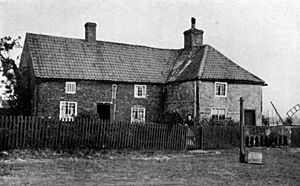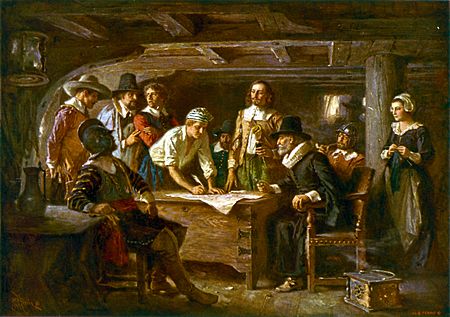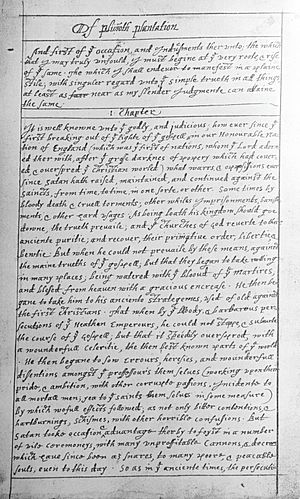William Bradford (governor) facts for kids
Quick facts for kids
William Bradford
|
|
|---|---|
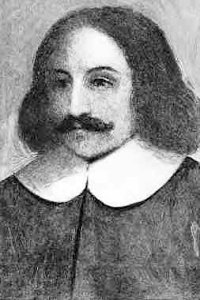
A conjectural image of Bradford, produced as a postcard in 1904 by A.S. Burbank of Plymouth
|
|
| 2nd, 5th, 7th, 9th & 11th Governor of Plymouth Colony | |
| In office May 1621 – 1 January 1633 |
|
| Preceded by | John Carver |
| Succeeded by | Edward Winslow |
| In office 3 March 1635 – 1 March 1636 |
|
| Preceded by | Thomas Prence |
| Succeeded by | Edward Winslow |
| In office 7 March 1637 – 5 June 1638 |
|
| Preceded by | Edward Winslow |
| Succeeded by | Thomas Prence |
| In office 3 June 1639 – 5 June 1644 |
|
| Preceded by | Thomas Prence |
| Succeeded by | Edward Winslow |
| In office 4 June 1645 – 9 May 1657 |
|
| Preceded by | Edward Winslow |
| Succeeded by | Thomas Prence |
| Commissioner of the United Colonies | |
| In office 1647–1647 |
|
| In office 1648–1648 |
|
| In office 1649–1649 |
|
| In office 1652–1652 |
|
| In office 1656–1656 |
|
| Personal details | |
| Born | ca. 19 March 1590 Austerfield, West Riding of Yorkshire, England |
| Died | 9 May 1657 (aged 67) Plymouth Colony |
| Spouses | Dorothy May Alice (Carpenter) Southworth |
| Children | 4 |
| Occupation | Weaver, settler |
| Profession | Colonial governor, judge |
| Portfolio | Treasurer, chief magistrate |
| Signature | |
William Bradford (born around 19 March 1590 – died 9 May 1657) was an English leader. He was a Puritan who wanted to separate from the official Church of England. He moved from England to Holland to escape being treated unfairly by King James I. Later, in 1620, he sailed to the Plymouth Colony in America on the famous Mayflower ship.
Bradford signed the Mayflower Compact, an important agreement for the new colony. He then served as the Governor of Plymouth Colony for about 30 years, between 1621 and 1657. He also helped lead the United Colonies of New England several times. His journal, Of Plymouth Plantation, tells the story of Plymouth from 1620 to 1646.
Contents
Early Life in England
William Bradford was born in Austerfield, England, and was baptized on March 19, 1590. His family owned a large farm and was considered wealthy.
William's childhood was tough because many family members died. His father passed away when William was just over a year old. When he was four, his mother remarried, and he went to live with his grandfather. Two years later, his grandfather died. William returned to live with his mother and stepfather, but his mother died a year after that, in 1597. At age seven, William became an orphan and moved in with two uncles.
His uncles wanted him to work on the farm. However, William wrote in his journal that he was often sick and couldn't work. Instead, he spent his time reading. He read the Bible and other classic books. This reading helped him become curious and interested in the Separatist ideas of the Puritans.
Joining the Separatists
When William Bradford was 12, a friend invited him to hear a preacher named Rev. Richard Clyfton. Clyfton believed the Church of England should remove all old Roman Catholic traditions to become a purer church. Bradford was very inspired by his sermons and kept going, even though his uncles told him not to.
At one meeting, Bradford met William Brewster, who worked as a bailiff and postmaster. Brewster lived near Austerfield. Bradford often visited Brewster, borrowed books, and heard stories about efforts to change the church in England.
Facing Persecution
When King James I became king in 1603, he said he would stop church reform. He would be harsh with anyone who criticized the Church of England. By 1607, about 50 people, led by Richard Clyfton and Rev. John Robinson, secretly met to worship. This group decided that reforming the Church of England was impossible. They chose to break away completely.
Their meetings soon caught the attention of the Archbishop of York. Many members were arrested in 1607. Brewster was found guilty of "disobeying in religious matters" and was fined. Some were jailed, and others were watched closely. The group also heard that other dissenters in London had been imprisoned and left to starve.
Because of this, the group decided in 1607 to leave England. They planned to go to the Dutch Republic, where people had religious freedom. William Bradford, then 18, decided to go with them. They faced many problems trying to leave. An English sea captain betrayed them, turning them over to the authorities. Most of the group, including Bradford, were briefly imprisoned. However, by the summer of 1608, they managed to escape England in small groups and move to Leiden in the Dutch Republic.
Life in Leiden

Bradford arrived in Amsterdam in August 1608. He was alone and was taken in by the Brewster family. The group had to take low-paying jobs and live in poor conditions because they were foreigners and had spent most of their money escaping England. After nine months, they moved to the smaller city of Leiden.
Bradford continued to live with the Brewster family in a poor area of Leiden. Things changed for him when he turned 21 in 1611. He was able to claim his family's inheritance. He bought his own house and started a workshop as a fustian weaver, making heavy cotton cloth. He became a respected member of the community. In 1613, he married Dorothy May, who was from a well-off English family living in Amsterdam. They had a civil marriage because they couldn't find a religious service example in the Bible. In 1617, their first child, John, was born.
In 1619, William Bradford sold his house in Leiden. By March 1620, tax records show him in London. He was living in an area known for Dutch merchants and religious dissenters. Many future Mayflower passengers lived there, like the Allerton, Tilley, Sampson, and Hopkins families.
One family in London, Edward and Alice (Carpenter) Southworth, would become important in Bradford's life in America. Edward Southworth was a respected leader of the Leiden group. After his death, his widow Alice moved to Plymouth Colony and later married William Bradford, after his first wife died.
Founding Plymouth Colony
Leaving for America
By 1617, the group from Scrooby began planning to start their own colony in America. In the Dutch Republic, they had religious freedom. However, they worried their children were becoming too Dutch. So, they spent three years negotiating in England for permission to settle in the northern part of the Colony of Virginia. They also worked out terms with a group of London investors called the Merchant Adventurers.
By July 1620, Robert Cushman and John Carver had made the arrangements. About fifty Separatists left Delftshaven on the ship Speedwell. It was an emotional goodbye. Many families were separated, as some Separatists stayed behind, planning to come later. William and Dorothy Bradford left their three-year-old son John with Dorothy's parents in Amsterdam. Perhaps he was too weak for the journey.
The Speedwell was supposed to meet the Mayflower off the coast of England. Both ships were headed for Virginia. But the Speedwell was not strong enough for the long trip. Some passengers moved to the Mayflower, making it very crowded. Besides the Separatists, about 50 other colonists joined them. These people were hired by the Merchant Adventurers for their skills, which would help build the colony. Today, all these passengers, both Separatist and non-Separatist, are known as "Pilgrims."
The Mayflower Voyage
The Mayflower left Plymouth, England, on September 16, 1620. The 100-foot ship carried 102 passengers and 30-40 crew members in very tight spaces. After about a month, strong winds hit the ship. The ship's wood shook badly, and water leaked in, making passengers wet and sick. Two people died during the trip: a crew member and a passenger.
After two months at sea, they saw Cape Cod on November 19, 1620. They tried for several days to sail south to their planned destination in Virginia. But strong winter seas forced them back to the harbor at Cape Cod, now called Provincetown Harbor. They anchored there on November 21, 1620. The Mayflower Compact was signed that day, and Bradford was one of the first to sign it.
First Explorations at Plymouth
Bradford was 30 years old but had not yet taken a major leadership role. The Mayflower anchored in Provincetown Harbor. He volunteered to join the groups exploring for a good place to settle. In November and December, these groups made three trips by foot and boat. They finally found Plymouth Harbor in mid-December and chose that spot for their settlement.
During the first trip on foot, Bradford got caught in an Indian deer trap and was pulled almost upside down! On December 6, 1620, the third exploration group (including Bradford) found Plymouth Bay. A winter storm almost sank their boat as they neared the bay. They managed to land on Clark's Island, suffering from severe cold and waves. In the following days, they explored the bay and found a good place to settle, which is now downtown Plymouth, Massachusetts. The spot had a large hill perfect for a fort. There were many streams for fresh water. It had also been an Indian village called Patuxet, so much of the land was already cleared for farming. The Patuxet tribe had been wiped out by diseases between 1616 and 1619. Bradford wrote that bones of the dead were visible in many places.
A Sad Loss
When the exploring party returned to the Mayflower, Bradford learned that his wife, Dorothy, had died. Dorothy (May) Bradford had fallen overboard from the ship while he was away and drowned in the icy waters of Cape Cod Harbor. William Bradford wrote about her death in his journal.
The Great Sickness
The Mayflower arrived in Plymouth Bay on December 20, 1620. The settlers began building their first house on December 25. However, their efforts slowed when a widespread sickness hit them. The sickness had already started on the ship. On January 11, 1621, Bradford was helping to build houses when he suddenly felt great pain in his hip and collapsed. He was taken to the "common house" (the only finished house then), and people feared he would not survive the night.
Bradford recovered, but many other settlers were not so lucky. During February and March 1621, sometimes two or three people died each day. By the end of winter, half of the 100 settlers had died. To hide their weakness from Native Americans who might be watching, the settlers buried their dead in unmarked graves on Cole's Hill, often at night, and tried to hide the burials.
During this terrible time, only a few men remained healthy enough to care for the sick. One of them was Captain Myles Standish, a soldier hired to organize the colony's defense. Standish cared for Bradford during his illness, and this started a strong friendship between them. Bradford was elected governor soon after the first governor, Carver, died. As governor, he worked closely with Standish. Bradford had no military experience, so he relied on Captain Myles Standish's advice for military matters.
Working with Massasoit
| Governors of Plymouth Colony | ||
|---|---|---|
| Dates | Governor | |
| 1620 | John Carver | |
| 1621–1632 | William Bradford | |
| 1633 | Edward Winslow | |
| 1634 | Thomas Prence | |
| 1635 | William Bradford | |
| 1636 | Edward Winslow | |
| 1637 | William Bradford | |
| 1638 | Thomas Prence | |
| 1639–1643 | William Bradford | |
| 1644 | Edward Winslow | |
| 1645–1656 | William Bradford | |
| 1657–1672 | Thomas Prence | |
| 1673–1679 | Josiah Winslow | |
| 1680–1692 | Thomas Hinckley | |
On March 16, the settlers met the American Indians for the first time. Samoset walked into Plymouth village as a representative of Massasoit, the leader (sachem) of the Pokanokets. This led to a visit from Massasoit himself on March 22. He signed a treaty with John Carver, the Governor of Plymouth. This treaty created an alliance between the Pokanokets and Plymouth, agreeing to help each other in war if needed.
Bradford wrote down the treaty's words in his journal. He soon became governor, and a key part of the treaty for him was about mutual aid. It said, "If any did unjustly war against [Massasoit], we would aid him; if any did war against us, Massasoit should aid us." This agreement gave the colonists a loyal friend in New England. However, it also caused tension between the colonists and Massasoit's rivals, like the Narragansetts and the Massachusetts.
Becoming Governor
In April 1621, Governor Carver collapsed while working in the fields on a hot day. He died a few days later. The settlers of Plymouth then chose Bradford as their new governor. He held this position off and on for the rest of his life.
At first, Plymouth Colony's elected leaders were a governor and an assistant governor. For the first three years, Isaac Allerton was the assistant governor. In 1624, the government changed to a governor and five assistants. These assistants were called the "court of assistants" or "magistrates." They advised the governor and could vote on important decisions. They helped Bradford guide the colony's growth and its new government. Early assistants included Thomas Prence, Stephen Hopkins, John Alden, and John Howland.
William Bradford's Writings
William Bradford's most famous work is Of Plymouth Plantation. It's a detailed history, written like a journal, about the founding of the Plymouth Colony and the lives of the colonists from 1621 to 1646. It's a detailed record of his experiences and observations. He wrote the first part in 1630 and updated it later in his life to cover the colony's struggles and achievements up to 1646.
Bradford often compared daily life and events to stories from the Bible. As Philip Gould wrote, Bradford wanted to show how God was working in their lives for future generations to learn from.
In 1888, Charles F. Richardson called Bradford a "forerunner of literature" and a "story-teller." Moses Coit Tyler called him "the father of American history." Many American authors have used his work in their own writings. For example, Cotton Mather mentioned it in Magnalia Christi Americana, and Thomas Prince used it in A Chronological History of New-England. Even today, it's seen as a valuable piece of American literature, studied in history classes. It has been called an American classic and a top work of art from 17th-century New England.
The Of Plymouth Plantation manuscript disappeared by 1780. It was likely taken by a British soldier during the British occupation of Boston. It later reappeared in Fulham, London, in the Bishop of London's library. There was a long debate about where the manuscript truly belonged. United States Senator George Frisbie Hoar and others tried many times to get it back. The British finally returned it to Massachusetts on May 26, 1897.
Bradford's journal also helped create the book Mourt's Relation, partly written by Edward Winslow and published in England in 1622. This book aimed to inform Europeans about the conditions for the American colonists in Plymouth. Bradford's Dialogues are fictional conversations between older and younger generations.
William Bradford's Family
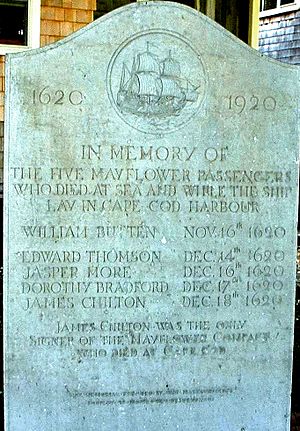
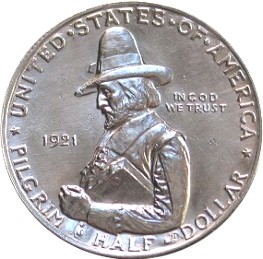
William Bradford married twice:
- He married Dorothy May in Amsterdam, Netherlands, on December 10, 1613. She was 16 years old and from Wisbech, England. William and Dorothy had one son.
- Dorothy's death: On December 17, 1620, Dorothy fell from the deck of the Mayflower into the icy waters of Cape Cod Harbor and drowned. Her husband was exploring ashore and only learned of her death when he returned.
- She was one of five Mayflower passengers who died in Cape Cod Harbor in December 1620. Their burial places are unknown. These deaths were just the start of many more, as about half of the Mayflower passengers died in that first harsh winter.
- He married Alice (Carpenter) Southworth, who was about 32, in Plymouth on August 14, 1623. She had arrived on the ship Anne a few weeks earlier. Alice was the widow of Edward Southworth. She brought two sons from her first marriage: Constant (born around 1612) and Thomas (born around 1617). Alice and William had three children together. She died in Plymouth on March 26, 1670, and was buried on Burial Hill in Plymouth, near her husband's grave.
Children of William and Dorothy Bradford:
- John was born in Leiden, Holland, around 1617. He married Martha Bourne by 1650 but had no known children. He died in Norwich, Connecticut, sometime before September 21, 1676.
Children of William and Alice Bradford:
- William was born on June 17, 1624, in Plymouth and died there on February 20, 1703/04. He was buried on Burial Hill in Plymouth.
- William married Alice Richard after April 23, 1650, and they had ten children. She died in Plymouth on December 12, 1671.
- He married Sarah (____) Griswold around 1674 and had one son.
- He married Mary (Atwood) Holmes around 1676 and had four children.
- Mercy was born before May 22, 1627. She may have died before her father's will in 1657, as she was not mentioned. She married Benjamin Vermayes on December 21, 1648, in Plymouth but had no known children.
- Joseph was born around 1630. He married Jael Hobart on May 25, 1664, in Hingham and had three children. He died in Plymouth on July 10, 1715.
Death and Burial
William Bradford died on May 9, 1657. He was buried on Burial Hill in Plymouth, where a memorial stone was placed in his memory.
See also
 In Spanish: William Bradford para niños
In Spanish: William Bradford para niños
- List of descendants of William Bradford (Plymouth governor)


